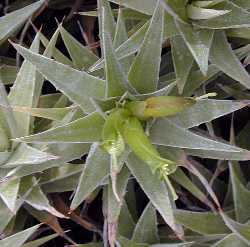Deuterocohnia brevifolia
Scientific Name: Deuterocohnia brevifolia (Grisebach) M.A.Spencer & L.B.Smith
Synonym: Abromeitiella brevifolia, Abromeitiella chlorantha
Family: Bromeliaceae
USDA: 9b-10
Frost Tolerance: hardy to 28°F (-2°C)
Heat Tolerance: Light shade in summer in Phoenix
Sun Exposure: Light shade to full sun
Origin: Northwestern Argentina, Bolivia
Growth Habits: Evergreen perennial ground cover, rosettes 1.2 to 2 inches in diameter (3 to 5 cm), forming a mound up to 3 feet in diameter; leaves with few marginal teeth (var. brevifolia) or many (var. chlorantha)
Watering Needs: Drought tolerant, but grows better with regular water
Propagation: Seeds, division

The genus Abromeitiella is named after the German botanist Johannes Abromeit. Deuterocohnia brevifolia are rosette-forming bromeliad that grow very slowly into tight mat or cushion shaped colonies. They look and grow like a small dyckia.
They are smaller than the related Deuterocohnia lorentziana. Some authorities recognize var. chlorantha. based on the size and many marginal bristle teeth.

Deuterocohnia brevifolia at the Huntington Gardens in the rain (HBG 18251)
Blooming Habits:
The flowers are green and come in early winter.
Culture:
They should be grown like succulents - in bright light and well-drained soil. While they are drought-tolerant, they do like water, especially during summer months.
Desert-Tropicals is dedicated to provide gardening advice, gardening ideas, and information about flower of all kind for landscape and collections.We try to check carefully the identification of the plants on the illustrations as well as the other information from the page, but occasionally errors do occur. if you notice anything that needs to be changed please contact us.Thanks.
© 1998-2020 Philippe Faucon, All Rights Reserved.
